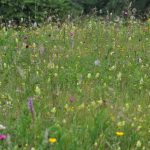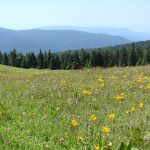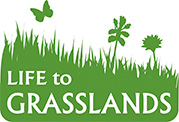In the course of the project we intend to improve the status of two priority Natura 2000 habitat types: Semi-natural dry grasslands and scrubland facies on calcareous substrates (Festuco-Brometalia) (*) important orchid sites and Species-rich Nardus grasslands, on siliceous substrates in mountain areas (and submountain areas in Continental Europe).
 The habitat type, which the experts refer to as semi-natural dry grasslands and scrubland facies on calcareous substrates (Festuco-Brometalia), can be found in Haloze, Kum, and Gorjanci. These meadows are also rich with wild orchids. Such meadows can also be found in Goričko, Kozjansko, Bela Krajina….
The habitat type, which the experts refer to as semi-natural dry grasslands and scrubland facies on calcareous substrates (Festuco-Brometalia), can be found in Haloze, Kum, and Gorjanci. These meadows are also rich with wild orchids. Such meadows can also be found in Goričko, Kozjansko, Bela Krajina….
 The habitat type, which the experts refer to as the species-rich Nardus grasslands, on siliceous substrates in mountain areas, covers the vast plains of Pohorje. The meadows of Pohorje are enriched by colourful endangered plants, such as arnica and Hungarian gentian. Such meadows can also be found in Karavanke, Smrekovec Mountains, Banjšice, Porezen….
The habitat type, which the experts refer to as the species-rich Nardus grasslands, on siliceous substrates in mountain areas, covers the vast plains of Pohorje. The meadows of Pohorje are enriched by colourful endangered plants, such as arnica and Hungarian gentian. Such meadows can also be found in Karavanke, Smrekovec Mountains, Banjšice, Porezen….
Semi-natural dry grasslands and scrubland facies on calcareous substrates
Dry grasslands are characterised by grasses and wild flowers growing on shallow and nutrient-poor soils with low and sparse turf. Created by man, they are still being maintained by moderate mowing or grazing, while many farmers combine both. Old varieties of fruit trees were often planted on such grasslands. Therefore, they can also be found in meadow orchards. In Slovenia, dry grasslands are found in permeable karst landscapes and in hinterlands, where they grow on sunny southern sides of slopes and hills. Experts call this type of grasslands semi-natural dry grasslands and scrubland facies on calcareous substrates (Festuco-Brometalia) (*important orchid sites). In eastern Slovenia they can be found in the hilly areas of eastern (wine-growing) and western Haloze, Donačka mountain and in the Posavje hills with its highest peak Kum. Smaller areas of dry and semi-dry grasslands (so-called meadows) with rich biodiversity are located in the middle of wooded Gorjanci with the plateau Radoha. They can also be found in Goričko, Kozjansko, Bela Krajina, the Polhograjsko hills and elsewhere. Dry grasslands are among the most endangered habitats in Slovenia.
They are a treasure trove of plants, including wild orchids and different animals
Dry grasslands are characterised by a rich diversity of plant and animal life; up to 80 different species can be found in an area of one square metre. Some of them are protected and endangered. The greatest diversity of species is in moderately or extensively used grasslands. Typical and easily identifiable plants growing on dry grasslands are grasses (erect brome, tor-grass and quaking-grass) and thermophilous herb species (common sainfoin, ox-eye, cloves or carnations, silver thistle, hoary plantain, rattle, Carnolian lily). Meadow pearls (wild orchids) bloom in May and June. The rich diversity of plant life provides a favourable environment for a large variety of insects, butterflies, grasshoppers, bugs, praying mantis, and beetles. Due to the rich diversity of insects, many bird species are also found in dry grasslands.
